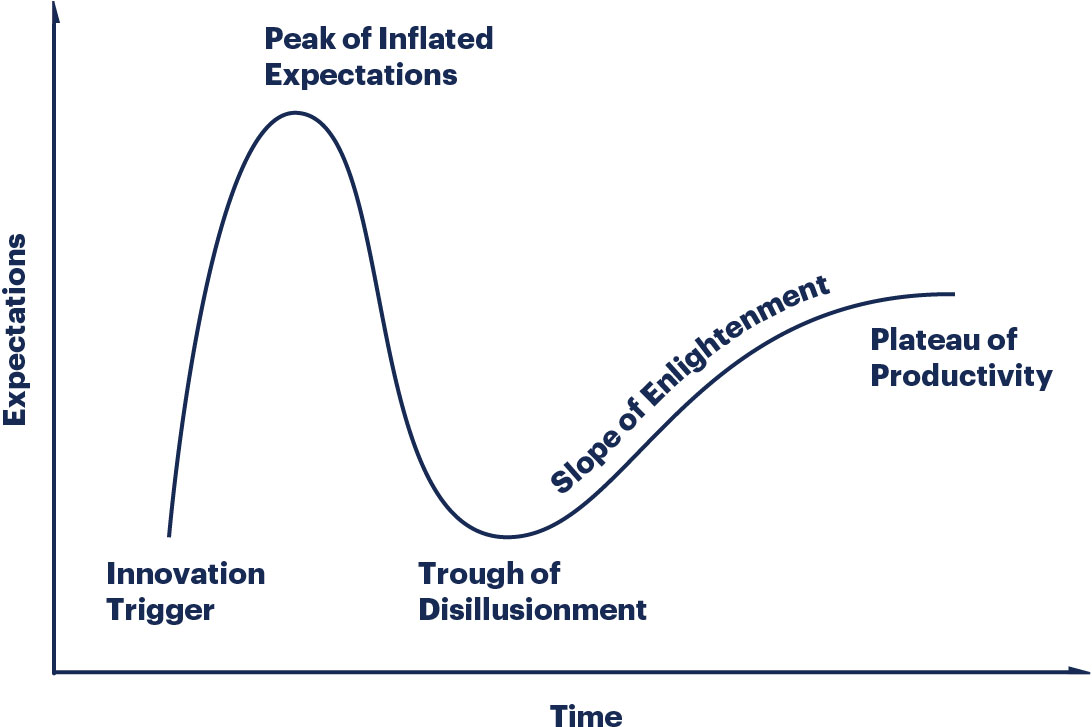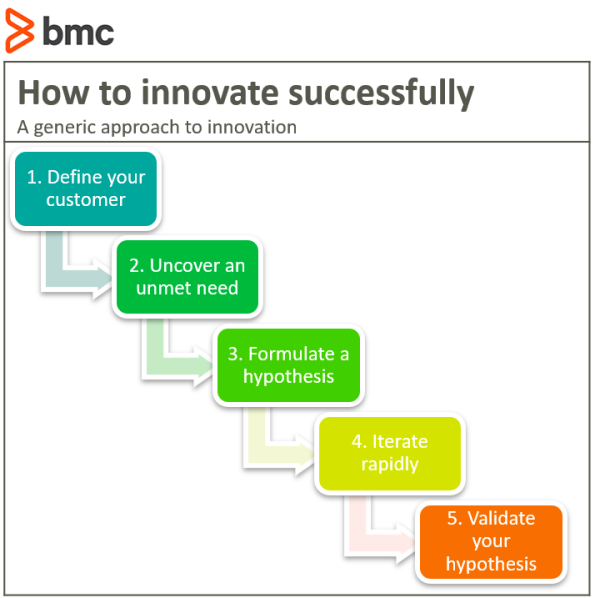We’ve now reached the Slope of Enlightenment. A product has been ideated. It has been taken to the extremes of imagination. It has been tried and tested in R&D phases. All fantasies about the social impact and the possibilities of the product have been rooted in what is possible and what is not. This is a beautiful stage for any product.
Here, we’ve reached a period of Renaissance. Let’s see what it looks like.
What is the slope of enlightenment?
The Gartner Hype Cycle identifies five key phases during a new technology’s development. During the Slope of Enlightenment, the fourth phase, a product gets to do all the things any product strives to accomplish: exist. It has passed the durability tests, venturing out into the woods to live with the wolves, and returns home accepted in the community as “one of them”.
This phase is characterized by:
- A team who is confident in their work
- High levels of productivity
- More people who want to get involved
- An easier time making progress

(Source)
Contrast the slope of enlightenment to the previous three phases. The beginning phases for any new product are chaotic; there exists lots of uncertainty. Previous phases have taken an idea and shaped it into something that is possible. As soon as a reality sets in, even new ideas have a much higher rate of contributing to the product’s end goal.
But here, in the enlightenment, the chaos rate falls. The team calms, the error rate decreases. The project’s direction is a lot clearer, more certain. It is easier to communicate where the project is headed.
Confidence
Now, team members can wear fewer hats. Before a product reached enlightenment, team members had to adapt quickly. The project direction was unclear, testing was dynamic, resource needs changed daily. Projects early in the hype cycle consist of only a few people with a lot of multi-disciplinary know-how and an ability to adapt.
When the product enters a moment of enlightenment, team members can now focus on just one task or area. There is less uncertainty to where a project is headed. Goals are created and stay in place, so it is easier to hire team members who have specialized skills.
Specialization allows management to assign a task and know that it will be executed with quality. This contributes to a culture of confidence, from everyone, that adds to the overall value of the product.
Here’s an example of this confidence: A skillfully written Dockerfile is not as valuable in a product’s initial testing—the entire container design might get scrapped in just a few iterations. But in an environment with increased certainty, the well-written Dockerfile, authored by a someone who has written thousands, suddenly becomes much more valuable. It serves a purpose for a much longer period of time. When the Dockerfile does need to change, the range in variation will be much smaller and easier to execute.
In this phase, your company’s time, direction, and investment dollar go much farther.
Productivity
With well-defined goals, everything the teams does makes it further and faster—and with less effort! The wheel on the carriage has been ground into a well-rounded circle, the axel’s been greased, and now the system can just…move.
“It happens with less effort!”
Specialization allows quality work to be done on individual tasks. A year can be spent polishing a diamond, rather than rapidly producing coals. Money is used more wisely. Ideation is also more effective: all the bad ideas have been rinsed from the system. Momentum is built, the carriage is already rolling, and it is easier to separate a bad idea from a good one.

In its early phases, Netflix could have explored ideas about building its own consumer hardware, such as Redbox-like vending machines. Now, however, the Netflix question has evolved well past that. They know their product offering, and they can easily say, “That’s not it.” It no longer gets off-base kinds of product ideas. Instead, Netflix benefits from a more refined stream of ideas that make minor, nuanced differences to their product offerings.
More people
As the project’s trajectory is much more certain, people want to get involved in the hype. While team members are busy specializing, you likely need to scale up and add more people to the team.
Thanks to this new-found clarity, new hires have a quicker on-boarding process. They can be shown what to do and become more effective. They have a well-defined set of tasks. Joining the team during the enlightenment phase means new hires have very specific tasks—your team shifted from doing everything to doing something.
Public attention
When people see something that works (the well-refined machine of enlightenment), they are attracted to it. People want to work there. Investors want to put their money there. Imitators follow.
A positive feedback loop exists between people who work at a company and the people who want to work at the company. There is a tango between the audience and the performer, and both feed from the other’s reactions.
Money is used more effectively. In R&D, a company tells investors, “We hope to find something that works.” In enlightenment, the company gets to say, “Your money goes to X product, which makes us Y dollars.” Now, all the risk-hungry, adrenaline-seeking investors during the VC seed and Angel rounds don’t get as excited, but there are fewer of them and it’s an unstable game–we’re past that game. The product can garner more stable attention and acquire, similarly, more stable investment (longer term relationships) with Mezzanine, A- and B- level, investments.
On greased axles, the product has a steady ride forward. The future arises from the mist, and the vision gets shared by founders, team members, and investors. Next, the product would like to see its acceptance by the wider community and live in the hearts of many.
The Gartner Hype Cycle
Explore every phase of hype:
- The Innovation Trigger
- The Peak of Inflated Expectations
- Trough of Disillusionment
- Slope of Enlightenment
- Plateau of Productivity
Additional resources
For more on product development and innovation, check out these resources:
- DevOps Guide
- BMC DevOps Blog
- BMC Business of IT Blog
- The Software Development Lifecycle (SDLC): An Introduction
- Guide to IT Leadership & Best Practices
These postings are my own and do not necessarily represent BMC's position, strategies, or opinion.
See an error or have a suggestion? Please let us know by emailing blogs@bmc.com.






